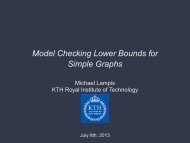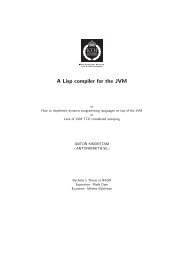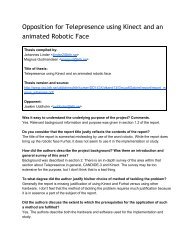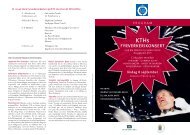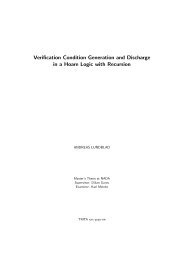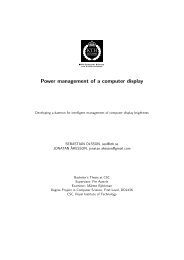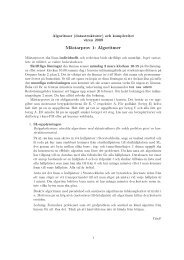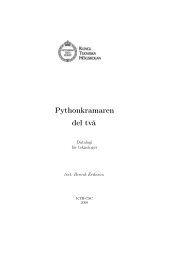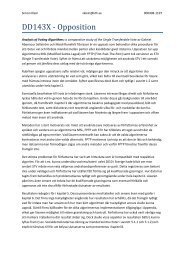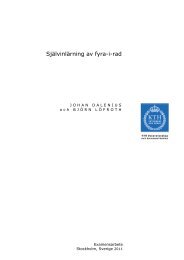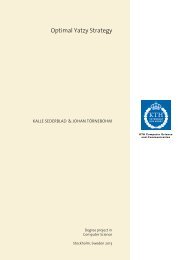Evaluation of Automatic Text Summarization - KTH
Evaluation of Automatic Text Summarization - KTH
Evaluation of Automatic Text Summarization - KTH
Create successful ePaper yourself
Turn your PDF publications into a flip-book with our unique Google optimized e-Paper software.
14 CHAPTER 1. SUMMARIES AND THE PROCESS OF SUMMARIZATION<br />
1.3.3.3 ISI ROUGE - <strong>Automatic</strong> Summary <strong>Evaluation</strong> Package<br />
ROUGE, short for Recall-Oriented Understudy for Gisting <strong>Evaluation</strong>, by Lin<br />
(2003) is a very recent adaption <strong>of</strong> the IBM BLEU (see section 1.3.1.7) for Machine<br />
Translation that uses unigram co-occurrences between summary pairs. According<br />
to in-depth studies based on various statistical metrics and comparison to<br />
the results DUC-2002 (Hahn and Harman 2002), this evaluation method correlates<br />
surprisingly well with human evaluation (Lin and Hovy 2003).<br />
ROUGE is recall oriented, in contrast to the precision oriented BLEU script,<br />
and separately evaluates 1, 2, 3, and 4-grams. Also, ROUGE does not apply any<br />
length penalty (brevity penalty), which is natural since text summarization involves<br />
compression <strong>of</strong> text and thus rather should reward shorter extract segment as long<br />
as they score well for content. ROUGE has been verified for extraction based<br />
summaries with a focus on content overlap. No correlation data for quality has<br />
been found so far.<br />
1.3.3.4 <strong>KTH</strong> eXtract Corpus and Tools<br />
At the Royal Institute <strong>of</strong> Technology (<strong>KTH</strong>), Hassel has developed a tool for collection<br />
<strong>of</strong> extract based summaries provided by human informants and semi-automatic<br />
evaluation <strong>of</strong> machine generated extracts (Hassel 2003, Dalianis et al. 2004) in order<br />
to easily evaluate the SweSum summarizer (Dalianis 2000). The <strong>KTH</strong> eXtract<br />
Corpus (<strong>KTH</strong>xc) contains a number <strong>of</strong> original texts and several manual extracts<br />
for each text. The tool assists in the construction <strong>of</strong> an extract corpus by guiding<br />
the human informant creating a summary in such a way that only full extract units<br />
(most <strong>of</strong>ten sentences) are selected for inclusion in the summary. The interface<br />
allows for the reviewing <strong>of</strong> sentence selection at any time, as well as reviewing <strong>of</strong><br />
the constructed summary before submitting it to the corpus.<br />
Once the extract corpus is compiled, the corpus can be analysed automatically<br />
in the sense that the inclusion <strong>of</strong> sentences in the various extracts for a given source<br />
text can easily be compared. This allows for a quick adjustment and evaluation<br />
cycle in the development <strong>of</strong> an automatic summarizer. One can, for instance,<br />
adjust parameters <strong>of</strong> the summarizer and directly obtain feedback <strong>of</strong> the changes<br />
in performance, instead <strong>of</strong> having a slow, manual and time consuming evaluation.<br />
The <strong>KTH</strong> extract tool gathers statistics on how many times a specific extract<br />
unit from a text has been included in a number <strong>of</strong> different summaries. Thus,<br />
an ideal summary, or reference summary, can be composed using only the most<br />
frequently chosen sentences. Further statistical analysis can evaluate how close<br />
a particular extract is to the ideal one. The tool also has the ability to output<br />
reference summaries constructed by Majority Vote in the format SEE (described in<br />
section 1.3.3.1) uses for human assessment.<br />
Obviously, the <strong>KTH</strong>xc tool could easily be ported to other languages and so<br />
far corpus collection and evaluation has been conducted for Swedish as well as



